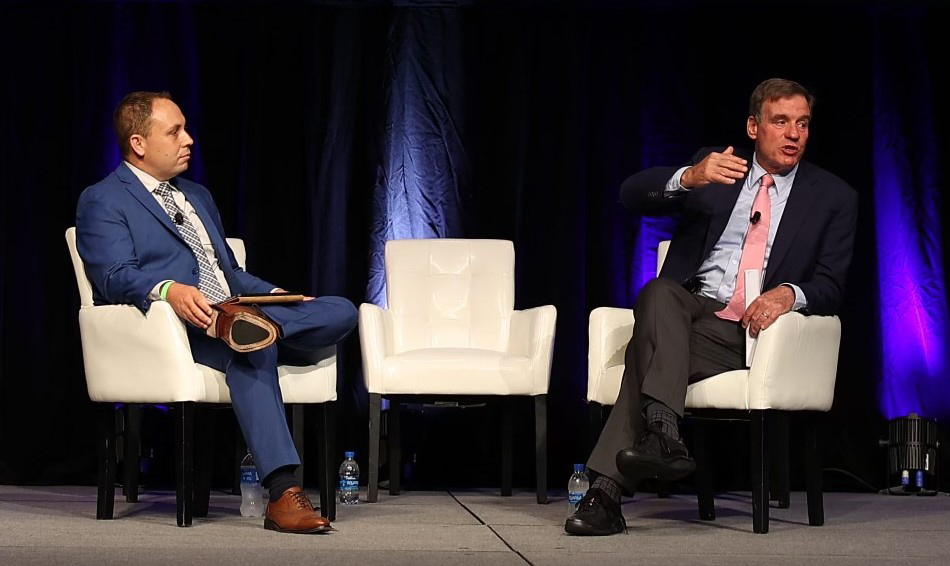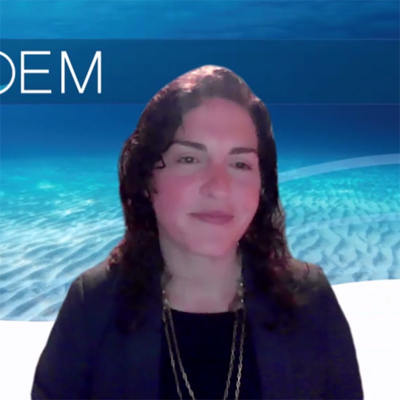
RICHMOND, Va. — Before he was Virginia’s governor or a member of Congress, Sen. Mark Warner (D-Va.) made a fortune as one of the founders of cellular service provider Nextel.
“I feel like offshore wind is about where the wireless industry was in the mid-80s,” Warner told the Business Network for Offshore Wind’s International Partnering Forum (IPF) on Thursday. “The smart folks in wireless — the old Bell operating companies and Wall Street — said it’s going to take 30 years to build out a wireless network in this country, and at the end of that 30 years about 5% of Americans are going to have cell phones. I got rich because they were wrong. I’d like all you guys to get rich.”
About 1,000 wind developers and would-be subcontractors hoping to do just that attended the three-day IPF at the Greater Richmond Convention Center, joined by officials of East Coast states hoping that OSW will be a boon to their economies.
Under President Biden, who set a goal of 30 GW of OSW by 2030, prospects for the industry have brightened considerably, speakers at the conference agreed, even as they acknowledged the need to move even faster to achieve state and federal climate goals.

“I don’t think it’s an exaggeration to say this administration is going to be the best partners you’ve ever had in the federal government,” said Energy Secretary Jennifer Granholm, one of several administration officials who joined the conference virtually. “We want to see [this] business booming so we can reach 100% clean electricity by 2035.”
Former President Donald Trump famously fought an offshore wind development near his golf course in Scotland and alleged that wind turbines cause cancer. Renewable advocates accused Trump of trying to thwart the industry after the Interior Department’s Bureau of Ocean Energy Management (BOEM) ordered additional environmental reviews of the Vineyard Wind project in 2019. (See Renewable Backers Decry Vineyard Wind Delay.)
‘Out of the Blocks’
But that’s ancient history, said Deputy Interior Secretary Tommy Beaudreau, who was BOEM director in the Obama administration.
“These are exciting times. It’s only been about eight months, but [BOEM Director] Amanda [Lefton] and her team have come out of the blocks very fast” in support of the industry, Beaudreau said.

Lefton also spoke via video, ticking off the bureau’s efforts and the industry’s accomplishments in 2021.
In May, BOEM gave final approval for 800-MW Vineyard Wind I, the first commercial-scale offshore wind project in U.S. federal waters. (See BOEM Approves 800-MW Vineyard Wind I.)
It also has begun environmental reviews of six other OSW projects, and Lefton said more are expected to be announced later this year. It plans lease sales for the New York Bight by the end of this year or early 2022 and for off North Carolina and California as soon as next year.
Earlier this month, BOEM published the final environmental impact statement for South Fork Wind, which would be the second commercial-scale OSW project approved in U.S. waters.
“There are important and exciting demands in areas like the … Mid-Atlantic, where we know we need to explore the potential for new lease areas to help Virginia and North Carolina and other states in the area meet their renewable energy goals. We also want to make sure that we’re taking a hard look at places like the Gulf of Maine, where we know there’s tremendous interest by New Hampshire and Massachusetts and Maine to explore the potential … for floating wind,” she said.
“We know that we’re starting with 42 MW of offshore wind currently installed in the United States. … We know that in order for us to get from where we are today to [30 GW by] 2030, there are a lot of challenges, but also with those challenges come incredible opportunities.”
Economic Impacts Being Seen
The first economic impacts of the industry are beginning to be seen, Granholm said, noting Dominion Energy’s plans for an OSW installation vessel being constructed in Texas using steel produced in West Virginia and Alabama. “And then [the vessel is] going to help construct at least two offshore wind projects in the Northeast,” Granholm continued. “So these turbines [are] going to generate both clean energy and economic benefits that will reach America’s heartland even if the wind turbines themselves are offshore on the coasts. Offshore wind is going to bring jobs to communities that have been left behind, like for example, Sunset Park in Brooklyn, where local workers there are going to be assembling wind turbines at a new marine terminal.”
Lefton cited announcements of manufacturing facilities in New Jersey and at a Pennsylvania steel mill to supply monopiles, a foundation manufacturing facility in Rhode Island and a facility to manufacture wind towers and “transition” pieces in New York.
During the conference, the Port of Virginia announced it would lease 72 acres of its Portsmouth Marine Terminal to Dominion for 10 years to support development of the utility’s 2.6-GW Coastal Virginia Offshore Wind (CVOW) project. Wind developer Ørsted agreed last year on an initial 1.7-acre lease at the terminal — with an option to expand to an additional 40 acres — that it will use in staging on CVOW and potentially other projects. (See related story, Dominion Secures 10-Year Va. Port Lease for OSW Staging.)
Ørsted and Eversource Energy, its partner in the South Fork project, also used the conference to announce a contract with Kiewit Offshore Services to construct an offshore substation near Corpus Christi, Texas, with support from teams in Houston and Kansas.
Lefton said BOEM is working to make environmental reviews more efficient, both by improving coordination within the federal government and changing how it conducts outreach.
“We recognize here at BOEM the critical nature of working regionally. And it’s in fact why you’ve seen BOEM over time move away from a state-by-state approach to these regional intergovernmental task forces.”
The Biden administration is using White House interagency meetings to make sure the bureaucracy is unified in support of meeting the 30-GW goal.
“By bringing everyone around the table and identifying challenges and opportunities up front, we’re able to ensure that we have a strong process going forward, where we’re all aligned on a path,” Lefton said.
Sen. Warner praised Lefton for agreeing to tap the expertise of the Army Corps of Engineers to supplement BOEM staff on OSW reviews, calling her “very, very receptive.” But he said regulators should increase their use of modeling and simulation software and artificial intelligence to make reviews faster.
‘Dramatic Change’ in Congress
Warner said he has seen “a pretty dramatic change” among many of his Republican colleagues on climate change in the last year, as episodes of extreme weather have become increasingly frequent.
“It may not have been represented yet in voting changes. But whether you look at the floods in Tennessee, the [tropical storm] in New England, the fires in the West or simply walking outside in [90-degree temperatures] in Richmond in August,” the evidence of climate change is inescapable, Warner said. “We used to get one day or two days like this a year. This has been virtually our entire summer.
“Part of the [political] challenge is almost nomenclature,” he added. “In Hampton Roads we don’t call it climate change as much as we call it sea-level rise. If we can get 80% of the voters to agree on [the existence of] sea-level rise,” policies will change.
Of the $65 billion in the energy title of the bipartisan infrastructure bill approved by the Senate earlier in August, “most of that is climate-related,” Warner said. He cited spending for capping abandoned oil and gas wells, spending on resilience and “seed money” for electric vehicle charging stations.
He also cited $17 billion for port improvements. He said Virginia leaders are “working the Navy right now to both deepen and widen our port and hopefully actually be able to have the ability to bring a container ship in and a Navy carrier out at the same time.”
Republicans also can find common ground with Democrats in ensuring U.S. businesses benefit from decarbonization efforts, Warner said. “The U.S. is going to buy 25,000 new school buses over the next five years. Right now, unless we grow a domestic electric … bus industry, about 90% of those buses are going to be built in China. That makes no sense from a national security standpoint; no sense from a jobs standpoint. So we had broad-based support on that.”


